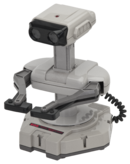Gyromite
| Gyromite | |
|---|---|
| Original title | ジ ャ イ ロ |
| transcription | Jairo |
| Studio | Nintendo Research & Development 1 |
| Publisher | Nintendo |
| Erstveröffent- lichung |
|
| platform | Nintendo Entertainment System |
| Game mode | Single and two player modes |
| control | NES controller |
| medium | Cartridge |
Gyromite , also known as Robot Gyro (Japanese: ジ ャ イ ロ ), is a video game for the Nintendo Entertainment System (NES) released in 1985. It is one of only two games that can be controlled using the Robotic Operating Buddy (ROB) ; the other is stack-up . Gyromite is one of Nintendo's earliest developments for the NES.
action
Professor Hector (player 1) and his assistant Professor Vector (optional player 2) wander through their laboratory with the help of their best creation, ROB. They are threatened by randomly distributed dynamite and aggressive bird-like green creatures. Hector's goal is to collect all the dynamite sticks in order to avert the danger.
In addition to the endangered laboratory, Hector's sleepwalking also ensures dangerous tours for the professor.
control
The professor moves with the help of the first controller, while the red and blue columns, which are spread across the playing field, can be steered up and down with the second controller. ROB can take over the second controller . To control the Nintendo gaming robot, the player presses the start button on the first controller, whereupon the screen turns blue and ROB waits for a command by means of an optical sensor. Pressing the A or B button causes the robot to pick up a gyroscope attached to the side and use it to press the corresponding button on the second controller via an apparatus. This then moves the blue or red columns in the game and opens up new paths for the professor.
Game modes
Gyromite offers two different game modes (A and B) as well as a test and a direct mode in its main menu.
Game a
The first game mode is intended for one (Hector) or two players (Hector and Vector), whereby in the latter case both games must alternate on the same controller.
Game A is about navigating the professor through his laboratory and collecting all the dynamite sticks before the timer runs out and without being caught by one of the green Smicks. With the help of a beetroot , which can be found everywhere, the professor can distract the Smicks and thus make them harmless. Since Hector and Vector cannot jump, they have to climb the various platforms of the small levels with the help of green ropes or be transported by the blue and red columns controlled by ROB. Once all of the dynamite has been collected and the room has been secured, you can move on to the next of 40 levels.
Collected dynamite sticks, Smicks crushed by the moving columns and the time remaining after completing a level ensure points on a points account. Each professor initially has five lives; he loses one if he gets a smick, crushes himself with a pillar, or runs out of time. Then he has to start the same level again.
Game B
The second game mode is only intended for one player. The point here is to clear the way to the right edge of the screen for sleepwalking Professor Hector. Only ROB can be controlled here. Therefore, a command to the robot does not need to be announced with the start button of the controller, as is usually the case. Hector starts at the left edge of the screen and moves slowly but automatically to the right until he reaches the right side with ROB's help.
test
The test mode is only used to confirm ROB's ability to receive light commands from the screen. Pressing the Select button sends a signal to the robot, which should cause its red LED to light up.
Directly
No game is played here, only ROB remote-controlled. The various buttons on the controller ensure certain movements of the Nintendo robot: up and down, the arms rise or fall, the arms turn left and right clockwise or counterclockwise. A opens her arms and B closes them again.
Game name and Famicom adapter
Although the game is called Gyromite outside of Japan, the menu screen shows the Japanese name Robot Gyro because the game was adopted one-on-one for the non-Japanese market. Early American and European versions differ from the Japanese original only in one adapter, with the help of which the original Famicom game can be used on an NES. Famicom uses a 60-pin connector between the game and console, the NES a 72-pin connector.
Web links
Individual evidence
- ^ Grant Brunner: How console add-ons have changed the face of gaming , extremetech.com. Retrieved January 3, 2015
- ^ Nintendo of America: Booklet by Gyromite .
- ↑ Benj Edwards: How to Tell if a Copy of Gyromite has a Famicom Adapter in it , vintagecomputing.com. Retrieved January 3, 2015
